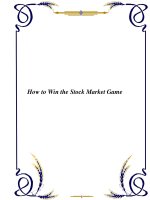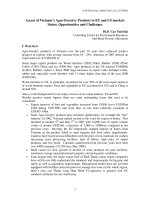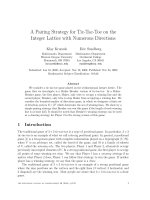Marketing strategy for Vietnam Airlines to penetrate the US market
Bạn đang xem bản rút gọn của tài liệu. Xem và tải ngay bản đầy đủ của tài liệu tại đây (1.3 MB, 62 trang )
MINISTRY OF EDUCATION & TRAINING UNIVERSITEÙ LIBRE DE BRUXELLES
HO CHI MINH CITY OPEN UNIVERSITY SOLVAY BUSINESS SCHOOL
MBMM PROGRAM
TRAN QUANG HOA
MARKETING STRATEGY FOR VIETNAM AIRLINES
TO PENETRATE THE US MARKET
FINAL PROJECT
MASTER IN BUSINESS & MARKETING MANAGEMENT
Ho Chi Minh City
2007
MINISTRY OF EDUCATION & TRAINING UNIVERSITEÙ LIBRE DE BRUXELLES
HO CHI MINH CITY OPEN UNIVERSITY SOLVAY BUSINESS SCHOOL
MBMM PROGRAM
TRAN QUANG HOA
MARKETING STRATEGY FOR VIETNAM AIRLINES
TO PENETRATE THE US MARKET
FINAL PROJECT
MASTER IN BUSINESS & MARKETING MANAGEMENT
TUTOR: DR. LE NGUYEN HAU
Ho Chi Minh City
2007
i
DECLARATION
I declare that the project entitled “Marketing strategy for VNA to penetrate the US
market” is my own work.
The information and data analysis of the project are based on reliable sources.
I hope that my project will be evaluated seriously and approved to recommend the
strategic program for VNA to penetrate the US market promptly.
ii
ACKNOWLEDGEMENT
I would like to express my deep sense of gratitude to my tutor Doctor Le Nguyen
Hau, who kindly supported and gave continuous guidance and precious
recommendations to this study. He gave cares for clear direction, methodology and
conceptual thinking to this study.
Further I would like to show my honest appreciation to my mentor Dao Viet Dzung,
General Manager of Passenger Sales and Marketing – Southern Regional Office,
HochiMinh city – Vietnam Airline for assistance and gave facilities for information
getting.
My sincere recognition is also for all of my lectures of the MBMM program, my
classmates, my colleagues and subordinates, my friends and my family for their
continuing encouragement and their assistance of my participation of this valuable
training program.
Ho Chi Minh City, Vietnam
TRAN QUANG HOA
Jun, 2007
iii
TUTOR COMMENTS
…………………………………………………………………………………………………………………………
…………………………………………………………………………………………………………………………
…………………………………………………………………………………………………………………………
…………………………………………………………………………………………………………………………
…………………………………………………………………………………………………………………………
…………………………………………………………………………………………………………………………
…………………………………………………………………………………………………………………………
………………………………………………………….……………………………………………………………
…………………………………………………………………………………………………………………………
…………………………………………………………………………………………………………………………
…………………………………………………………………………………………………………………………
…………………………………………………………………………………………………………………………
…………………………………………………………………………………………………………………………
…………………………………………………………………………………………………………………………
……………………………………………………………………………………………………………………….
iv
JURY COMMENTS
…………………………………………………………………………………………………………………………
…………………………………………………………………………………………………………………………
…………………………………………………………………………………………………………………………
……………………………………………………………………………………………….………………………
…………………………………………………………………………………………………………………………
…………………………………………………………………………………………………………………………
…………………………………………………………………………………………………………………………
…………………………………………………………………………………………………………………………
…………………………………………………………………………………………………………………………
…………………………………………………………………………………………………………………………
…………………………………………………………………………………………………………………………
…………………………………………………………………………………………………………………………
…………………………………………………………………………………………………………………………
…………………………………………………………………………………………………………………………
…………………………………………………………………………………………………………………………
v
EXECUTIVE SUMMARY
MANAGEMENT PROBLEM
Vietnam Airline (VNA) plans to launch a direct route to the US the beginning of
year 2008 and the problem is how can VNA penetrate the US market to compete
with other airlines and which strategy will apply to this market. It is the problem that
must be solved in this study.
THE PROJECT OBJECTIVE:
The objective of this project is:
To analyze the external and internal environment of VNA in relation to the US
market.
To develop marketing strategy for VNA to penetrate US market.
To recommend strategic program for VNA.
RESEARCH METHOD:
The process of solving this management problem is based on theories in strategic
management and marketing management and information in the external and
internal of Vietnam airlines are to be applied to solve this strategic management
problem.
PROJECT SCOPE:
Because of project limitation, this study will focus much on advertising strategy.
MARKETING STRATEGY:
Based on SWOT analyses and SWOT matrix to bring out the Marketing strategy for
VNA to penetrate the US market.
vi
In this project framework, we will focus much on advertising strategy for this
market.
BUILD UP ADVERTISING STRATEGY
Carry out this strategy in the period of 3 years from 2008 to 2010 as following:
2008 – Deep understanding – Sharing
- Main message: Vietnam Airline - outstanding at products, sale networks,
price policy - maximum satisfying the customers' need - being a close bridge for
family's members, reunions.
2009 - Affirmations
- Main message: Vietnam Airline is typical with international services and
technological standards - as the typical picture of a renewed Vietnam.
2010 - Constructing faith
- Main message: Vietnam Airline - highly responsible against community -
supporting and promoting, satisfying the developing need of socio economic of
country.
DESIRED RESULTS
Base on the customers’ profiles and features of US market, the advertising strategy
for this new market need to be archived the following targets:
- Introduce a new route to our potential customers.
- Advertise the preeminent products of VNA compared to the others,
especially the using new, modern aircraft – B777.
- Popularize our brand name to targeted passengers, making the difference in
customer mind about Vietnam.
- Coordinate closely with sales department.
vii
- Consolidate our good relationship with customers å build up the loyalty,
create the friendly image.
- In US market, the advertisement on media communication and newspaper
popularized in Vietnam community should focus on Vietnamese passengers,
Vietnamese sales agents. Concurrently, VNA should use US tourist companies to
advertise about VNA and Vietnam destination to launch overseas Vietnamese to
come back Vietnam for family reunion and business purpose.
- In Vietnam market, VN should introduce new products to travel agencies,
ticket agents and community via mass communication such as press, TV, brochures
and to hotels, local travel points and Embassies where many US experts and
oversea Vietnamese are working at.
viii
TABLE OF CONTENT
Declaration….…………………………………………………………………………………………………………………………………………i
Acknowledgement…………………………………………………………………………………………………………………… ……….ii
Tutor comments…………………………………………………………………………………………………………………………… iii
Jury comments………………………………………………………………………………………………………………………………….…iv
Executive summary…………………………………………………………………………………………………………………………….v
Table of content……………………………………………………………………………………………………………………………….viii
Appendix (Figure)………………………………………………………………………………………………………………………… xii
Appendix (Table)………………………………………………………………………………………………………………………… xiii
Abbreviations…………………………………………………………………………………………………………………………………….xiv
CHAPTER ONE
1. INTRODUCTION……………………………………………………………………………………………………………………….1
1.1 Background and Management Problem…………………………………………………………………………….1
1.2 The Project Objective……………………………………………………………………………………………………………….2
1.3 Research Method……………………………………………………………………………………………………………………… 2
1.4 Project Scope……………………………………………………………………………………………………………………………… 2
CHAPTER TWO
2. LITERATURE BACKGROUND………………………………………………………………………………………….3
2.1 Company Internal Analysis………………………………………………………………………………………………………3
2.2 Company External Business Environment…………………………………………………………………………3
2.2.1 Market and Customers……………………………………………………………………………………………………………4
ix
2.2.2 Competitor profile……………………………………………………………………………………………………………………4
2.2.3 Structural Analysis of the Industry…………………………………………………………………………………….4
2.3 SWOT Analysis…………………………………………………………………………………………………………………………….4
2.4 SWOT Matrix…………………………………………………………………………………………………………………………… 5
2.5 Strategy Formulation……………………………………………………………………………………………………………… 5
2.5.1 Marketing Strategy…………………………………………………………………………………………………………… … 5
2.5.1.1 Advertising strategy………………………………………………………………………………………………………… 5
CHAPTER THREE
3. EXTERNAL ENVIRONMENT ANALYSIS 6
3.1 General Introduction about US and VN – US relationship………………………………………….6
3.1.1 General……………………………………………………………………………………………………………………………………… 6
3.1.2 Population, overseas Vietnamese in US…………………………………………………………………………6
3.2 U.S Air Transport Market…………………………………………………………………………………………………………7
3.2.1 Outbound market…………………………………………………………………………………………………………………… 7
3.2.2 Inbound market…………………………………………………………………………………………………………………………8
3.3 Airline Transporting Market Between Vietnam and US…………………………………………… 8
3.3.1 Vietnam - US aviation market according to Origin & Destination……………………….8
3.3.2 Passengers structure……………………………………………………………………………………………………………… 9
3.3.3. Passengers distribution by US Departure/ Destination…………………………………………….9
3.3.4 Connection Gateway……………………………………………………………………………………………………………….9
3.3.5 Competitors profile……………………………………………………………………………………………………………….10
3.3.5.1 Competitive rate based on the origin/ destination in LAX/ SFO…………………… 10
3.3.5.2 Competition through the TPE Gateway…………………………………………………………………… 10
x
3.3.6 Feature of sale system………………………………………………………………………………………………………….10
3.4 Summary……………………………………………………………………………………………………………………………………….11
CHAPTER FOUR
4. INTERNAL ENVIRONMENT ANALYSIS………………………………………………………………….12
4.1 History and development process……………………………………………………………………………………….12
4.2 Flight network…………………………………………………………………………………………………………………………….13
4.3 Global Cooperation……………………………………………………………………………………………………………………13
4.4 VNA Fleet…………………………………………………………………………………………………………………………………….13
4.5 Service quality at passengers' sight…………………………………………………………………………………….14
4.6 Frequent Flyer program……………………………………………………………………………………………………………14
4.7 Advertisements……………………………………………………………………………………………………………………………14
4.7.1 Advertising strategy………………………………………………………………………………………………………………14
4.7.2 International advertisements………………………………………………………………………………………………14
4.7.3 Vietnam market advertisements……………………………………………………………………………………….15
4.8 Sponsoring operations………………………………………………………………………………………………………………15
4.9 Summary……………………………………………………………………………………………………………………………………….16
CHAPTER FIVE
5. STRATEGIC ANALYSIS AND CHOICE………………………………………………………………… 17
5.1 SWOT analyses………………………………………………………………………………… …………………………………….17
5.2 SWOT Matrix………………………………………………………………………………………………………………………………18
5.3 Marketing Strategy…………………………………………………………………………………………………………… …….18
5.3.1 Target segment……………………………………………………………………………………………………….………………18
xi
5.3.2 General strategy…………………………………………………………………… …………………………………….……….19
5.3.2.1 Differentiation strategy…………………………………………………………………………….………………………19
5.3.2.2 Joint venture strategy……………………………………………………………………………………………………….19
5.3.2.3 Competitive price strategy………………………………………………………………… …………………………19
5.3.2.4 Human resources developing and technology transfer strategy……………………….19
5.3.3 Product strategy……………………………………………………………………………………………………………………….19
5.3.3.1 Cooperation-product………………………………………………………………………………………………………….19
5.3.3.2 The ground and in-flight service………………………………………………………………………………… 20
5.3.4 Price and distribution policy……………………………………………………………………………………………….20
5.3.5 Promotion/ communication…………………………………………………………………………………………………21
5.3.5.1 Build up advertising strategy………………………………………………………………………………………….21
5.3.5.2 Picture advertisements………………………………………………………………………………………………………23
5.3.5.3 To systematize tactic advertisements………………………………………………………………………….23
5.3.5.4 Means………………………………………………………………………………………………………………………………………23
CHAPTER SIX
6. CONCLUSIONS AND RECOMMENDATIONS………………………………………………………….24
6.1 Conclusion…………………………………………………………………………………………………………………………………….24
6.2 Recommendations to VNA…………………………………………………………………………………………………….24
REFERENCES…………………………………………………………………………………………………………………………………….I
APPENDIX……………………………………………………………………………………………………………………………………………II
xii
APPENDIX (FIGURE)
Figure 1: Value- Creating activities (chapter: 2.1)……………………………………………………………… i
Figure 2: Company environment (chapter 2.2) ii
Figure 3: Five Forces Framework (chapter 2.2.3)…………………………………………………………………iii
Figure 4: SWOT Matrix (Chapter 2.4)……………………………………………………………………………………….iv
Figure 5: Strategy Formulation Process Flow in a Company (chapter 2.5)………………….v
Figure 6: Geography of United States (chapter 3.1)…………………………………………………………….vi
Figure 7: Overseas Vietnamese allocating in USA (chapter 3.1.2)……………… vii
Figure 8: US passenger total traveling abroad fr1995 to 2005(Chapter 3.2.1)…………viii
Figure 9: Tourist passenger total travel to US fr 1995 to 2005(Chapter 3.2.2)……….viii
Figure 10: VN- US airline market according to O & D (chapter 3.3.1)…………………………ix
Figure 11: Organization chart of Vietnam Airline (chapter 4.1)……………………………………….x
Figure 12: 10 Codeshare Agreements of Vietnam Airline (chapter 4.3)………………………xi
xiii
APPENDIX (TABLE)
Table 1: Structural Analysis of the Industry (chapter 2.2.3)……………………………………………xii
Table 2: SWOT analysis (Chapter 2.3)………………………………………………………………………………….xiii
Table 3: Bandy commercial between U.S and ASEAN (Chapter 3.1.2)………………… xiv
Table 4: VN -US airline market according to O & D (Chapter 3.3.1)…………………… xiv
Table 5: Distribute passengers by US Departure/Destination (Chapter 3.3.3)…………xv
Table 6: Passengers from Lax to Vietnam through gateway (chapter 3.3.4)…………….xv
Table 7: Passengers from SFO to Vietnam through gateway (chapter 3.3.4)………….xvi
Table 8: Service quality at passengers' sight (chapter 4.5)………………………………………… xvii
Table 9: Frequent Flyer program (chapter 4.6)…………………………………………………………………xviii
Table 10:
Strategical advertisements in typical markets (chapter 4.7.2)……………….xviii
Table 11: SWOT matrix (Chapter 5.2)…………………………………………………………………………………….xix
xiv
ABBREVIATIONS
VNA : Vietnam Airlines
IATA : International Air Transport Association
WTO : World Trade Organization
APEC : Asia-Pacific Economic Cooperation
GDP : Gross Domestic Product
FFP : Frequent Flyer Program
ARC : Airlines Reporting Corporation
BSP : Bank Settlement Program
O&D : Origin & Destination
B767/777 : Boeing 767/777
A320/321 : Airbus 320/321
F70 : Fokker70
AA : American Airlines
UA : United Airlines
CI : China Airlines
BR : Eva Air
SQ : Singapore Airlines
CX : Cathay Pacific
JL : Japan Airlines
KE : Korean Air
MH : Malaysia Airlines
PR : Philippines Airlines
xv
QF : Quantas Airways
TG : Thai Airways
US : United States
VN : Vietnam
CA : California
HAN : Hanoi
SGN : Saigon
LAX : Los Angeles
SFO : San Fransisco
TPE : Taipei
HKG : Hong Kong
BKK : Bangkok
KIX : Osaka
NRT : Narita
C class : Business class
Y class : Economy class
Yd class : Economy deluxe class
- 1 -
CHAPTER ONE
INTRODUCTION
1.1 BACKGROUND AND MANAGEMENT PROBLEM
Vietnam’s recent accession into the WTO creates big opportunities for VN
aviation market, but challenges will also rise to a higher level. The aviation
market has been expanded, thus Vietnam airline (VNA) has to try to develop
markets and its network of flight routes.
Besides, IATA (International Air Transport Association) acknowledged VNA as
IATA official member as from 5/12/2006. Becoming a member of IATA not only
brings about commercial benefits but also plays a significant part in reinforcing
the name of VNA. The trademark and symbol “Vietnam Airlines” will be added
to the member list of IATA, which will greatly contribute to reinforcing the
position of VNA in the international market as well as the quality of services that
VNA is offering to its passengers.
Currently VNA operate and code shared co-operate to 38 destinations around the
world including Europe, Asia, Australia and the Middle East. Domestically, VNA
fly to 18 destinations. Now VNA have 40 Aircrafts include: 10 Boeing 777, 08
Airbus321, 10 Airbus320, 10 ATR-72, 2 Fokker-70. The corporation planned to
increase its fleet to 86 aircrafts by 2015, expand international and domestic
routes. Next year, VNA plans to launch a direct route to the US. That is the goal
VNA expects to reach in the beginning of year 2008.
The biggest difficulty faced by VNA when launching the route to US is
competition, noting that 7 - 8 airlines currently transport passengers from the
United States to Vietnam and vice versa.
- 2 -
And the problem is how VNA can penetrate the US market to compete with
other airlines and which strategy will apply to this market. It is the problem that
must be solved in this study.
1. 2 THE PROJECT OBJECTIVE:
The objective of this project is:
To analyze the external and internal environment of VNA in relation to the US
market.
To develop marketing strategy for VNA to penetrate US market.
To recommend strategic program for VNA.
1.3 RESEARCH METHOD:
The process of solving this management problem is based on the strategic
management framework developed by Pearce and Robinson, 1997. The
competitive strategy is determined according to the concepts of Michael Porter,
1998
Theories in strategic management and marketing management and information
in the external and internal of Vietnam airlines are to be applied to solve this
strategic management problem.
1.4 PROJECT SCOPE:
Because of project limitation, this study will focus much on advertising strategy.
This strategy will help VNA directly to penetrate and influence target passengers
in the US market. Since then VNA will set up suitably strategies to apply to this
market.
- 3 -
CHAPTER TWO
LITERATURE BACKGROUND
2.1 Company Internal Analysis
• Vision:
The company’s vision is the desired future state. It is an aspiration around which
somebody might seek to focus the attention and energies of the organization.
• Mission:
The mission defines the purpose gives the reason for the existence of the
organization. It defines the fundamental, unique purposes that sets it apart from
other companies of its type and identifies the scope of its operation in terms of
products and services offered and market served.
• Objectives
The Objectives state rather precisely goals of the company, which are in line
with its mission.
• Profile
The company profile depicts the quantity and quality of the company’s financial,
human and physical resources.
• Value chain
Every firm is a collection of activities that are performed to design, to produce to
market, to deliver and to support its products. Value-creating activities consist of
five primary activities and four support activities (Figure 1).
2.2 Company External Business Environment
A guideline for analysis of the external environment is the “PEST” framework
(Figure 2) PEST stands for the Political, Economic, Social and technological
- 4 -
environment. (Johnson & Scholes, 2002 ) This analysis therefore includes social
country environment and the industry task environment.
2.2.1 Market and Customers
The traditional approach a customers and consumers analysis is based on
customer’s profile and consumer profiles, which is constructed from geographic,
psycho graphic variables and behavior information. Based on these information
the market is segmented (Philip Kotler, 1994)
2.2.2 Competitor profile
The analysis of the competitor profiles has several objectives: Identification of
the current and of potential competitors, identification potential strategic
competitor moves, identification of an effective strategy to compete.
Although the exact criteria used in constructing a competitor profile are variable
and determined by situational factors, the following criteria are commonly
includes: raw material costs, capacity and productivity, relative product quality,
price competitiveness, effectiveness of the marketing sales distribution, market
share, financial position, general reputation and experience.
2.2.3 Structural Analysis of the Industry
The five forces framework helps to identify the sources of competition in an
industry sector (Figure 3), (Table 1)
2.3 SWOT Analysis
The SWOT analysis is a technique to illustrate a quick overview of a company’s
strategic position. It illustrates a summary of the firm’s internal capabilities
(strengths and weaknesses) and its external environment (opportunities and
threats) (Table 2)
- 5 -
2.4 SWOT Matrix
SWOT matrix can facilitate the internal analysis of the firm. The study uses an
analysis which is based on the assumption that an effective strategy derives from
maximized firm’s strengths and opportunities and minimized weaknesses and
threats. (Figure 4)
2.5 Strategy Formulation
The diagram outlined process of a strategy formulation (Figure 5) Here a
paradigm is the set of assumptions held relatively in common and taken or
granted in an organization (Johnson & Scholes, 2002). Based on such a company
internal common sense the strategy suggestions are formulated.
2.5.1 Marketing Strategy
The marketing strategy intends capture a larger market share of an existing
market through market saturation and market penetration or development of new
markets for the current products.
2.5.1.1 Advertising strategy
Advertising is a non-personal form of promotion that is delivered through
selected media outlets that, under most circumstances, require the marketer to
pay for message placement.
Worldwide advertising media:
• Newspapers, Magazines, Professional and technical magazines
• Cinema, television, radio, outdoor advertising and transport advertising
• Interactive communication media, Place-based media (the fitness center,
supermarket, airport, in the aircraft…)
• Trade fairs and exhibitions, sponsorship of sport or art events.
• …………
- 6 -
CHAPTER THREE
EXTERNAL ENVIRONMENT ANALYSIS
3. 1 General Introduction about United States and Viet Nam – United States
Relationship
3.1.1 General
United States (US) is a large geography country. Including Alaska State at
Northwest Canada and Hawaii archipelago in Pacific Ocean, USA area is
9.159.123 km
2
, the 4
th
position in the world behind Russian, Canada, China,
holding 6.2% worldwide area. It’s 4.500 km from East to West and 2.500km from
North to South. (Figure 6)
3.1.2 Population, overseas Vietnamese in US
U.S has many euthenics groups, racial, cultural and languages. In July 2004, U.S
population is 293.027.571 people, 77.1% is white, 12.9% is black, 4.2% is Asian
(approximately 12 million), 1.5% is U.S aboriginal, 0.3% is Alaska & Hawaii
aboriginal and Pacific Islands and 4% from other origins
As US census in 2000, the overseas Vietnamese community in US is 1.2 million
people, including: 46.3% of overseas Vietnamese (approximately 566.519
people) live in Western state, especially in California and Washington, 15.28%
of overseas Vietnamese (approximately 187.018 people) live in South West
Central, especially in Texas, 12.42% of overseas Vietnamese (approximately
152.059 people) live in South Atlantic; The rest is allocated from 4-6% of
- 7 -
overseas Vietnamese live in Middle Atlantic, North Central , Mountain, South
Central. (Figure 7: overseas Vietnamese allocating in USA (US Census in 2000)
Political
U.S is divided in 50 states, each state has its law and constitution, but it isn't
against federal constitutional. Federal government seize the power management
including: general tax policies, foreign policy, international trade, bearing
responsibility for copyrights, national defense, metrology system, weights and
measures, money issuing.
Economy
US is an excess of imports over exports country, besides US build satellite
economic model to produce consumer goods and import back to US.
California (CA) has an economy that ranked seventh in the world economy with
gross income is 1.550 billion USD, occupied 13% of US GDP (Gross Domestic
Product). GDP per capita about 35.019USD. (Table 3)
3.2 U.S AIR TRANSPORT MARKET
3.2.1 Outbound market
- So in stage from 1995 to 2005, the U.S outbound passengers to foreign
country developed stably from 5% to 10% (excluding 2001 and 2002 which had a
terrorism on 11/9, the war in Iraq, there was a SARS epidemic in 2003 that
effecting to the U.S aviation market and the world seriously. (Figure 8)
- 8 -
- 5 big outbound markets in U.S: UK, France, China (including Hong Kong),
Italy, Germany.
3.2.2 Inbound market
Visitors coming to U.S with the commercial purpose is 24%, approximately 5
million guests per year, traveling and visiting relatives is around 76%
approximately 15 million guests per year.
Businessman coming to U.S is mostly at the Eastern states and California in
West. Most of businessman come in/out U.S that have resident period of time in
U.S is 6 days normally.
There is 77% tourist coming to U.S with the main purpose is traveling., 14% for
visiting relative plus travel and joining to another events for remaining. Resident
period of time in U.S is 8 days normally. (Figure 9)
3.3 AIRLINE TRANSPORTING MARKET BETWEEN VIETNAM AND
UNITED STATES
3.3.1. Vietnam - US aviation market according to Origin & Destination
In the year 2006, US-Vietnam aviation market have achieved 339,600
passengers which 94.15% is passengers from US to Vietnam (320,409
passengers), and 5.85% is passengers from Vietnam to US (19,191 passengers).
Forecasting, number of passengers between US and Vietnam will grow
continuously with high speed of 15% to 20% per year in the period of 2007 to
2010, especially, after Vietnam joins The World Trade Organization.
development ratio can be decreased a little and stable at the average of 10% per
year in the following five years. (Table 4) (Figure 10)









